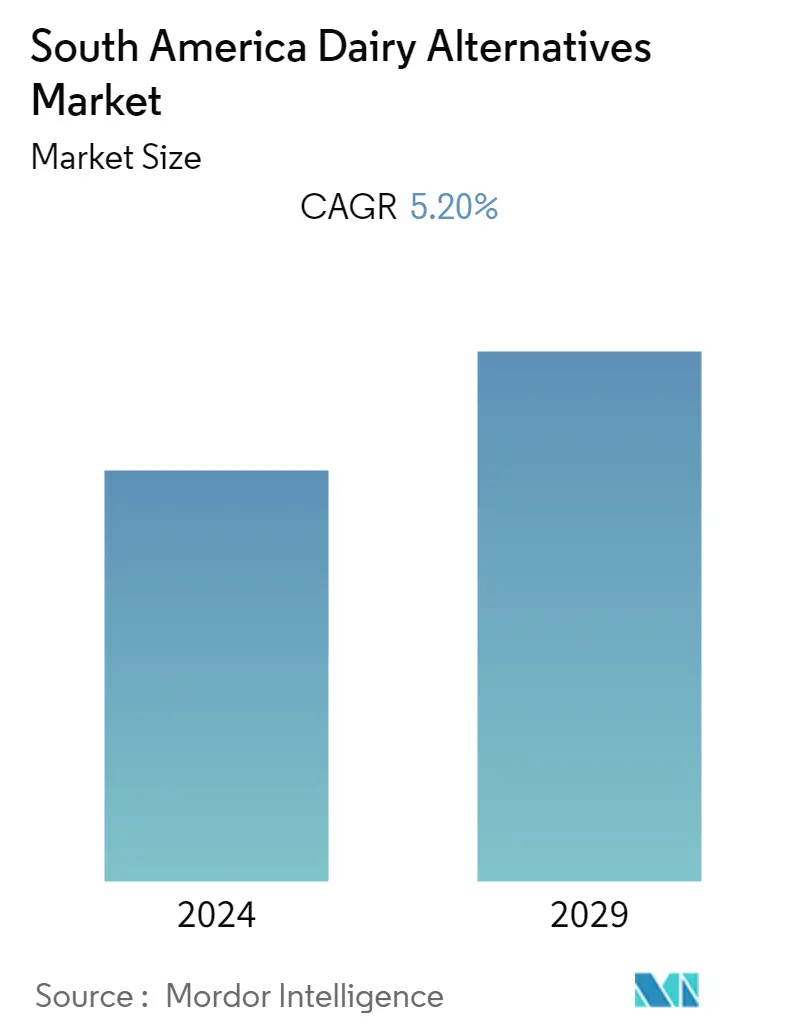Market Size of South America Dairy Alternatives Industry

| Study Period | 2019 - 2029 |
| Base Year For Estimation | 2023 |
| Forecast Data Period | 2024 - 2029 |
| Historical Data Period | 2019 - 2022 |
| CAGR | 5.20 % |
| Market Concentration | High |
Major Players.webp)
*Disclaimer: Major Players sorted in no particular order |
South America Dairy Alternatives Market Analysis
South America's Dairy Alternative products market is forecast to register a CAGR of 5.2% during the forecast period (2022-2027).
The emergence of the COVID-19 scenario made major changes in the market, positively impacting its' growth. The increased health consciousness stemming from covid precautions has led to the increased preference for plant-based milk.
The gaining popularity of the vegan diet and incidences of lactose intolerance drive the market. Increased health consciousness among consumers has led to the demand for functional beverages. The development of palatable and nutritionally adequate functional beverages with plant-based derivatives drives the market. Also, the increasing milk allergies resulting in adverse immune reactions after ingesting animal milk among the global population, particularly children and infants, has become another major factor driving the market.
However, the comparatively high prices of dairy alternatives pose a challenge to the market. The presence of nutritionally equivalent alternatives for a lower price affects consumer behavior and refrains the purchase of dairy alternatives.
South America Dairy Alternatives Industry Segmentation
Dairy alternatives are consumer products that do not contain lactose and possess all the properties of milk. South America Dairy Alternative Products Market includes dairy-free food such as Plant-based milk, Frozen desserts, Yogurt, and Others. The others include sour cream. Dairy-free beverages include Soy milk, Almond milk, Coconut Milk, Rice milk, and other types. The other beverages include cashew, pea, oat, and hemp, by sales channel into Supermarkets/Hypermarkets, Convenience stores, Online Stores; and others. The other sales channel include warehouses, discounters, kiosks, vending machines, etc. The report offers market size and forecasts for the dairy alternative market in value (USD million) for all the above segments.
| By Type | |
| Soy-based | |
| Almond-based | |
| Coconut-based | |
| Rice-based | |
| Other types |
| By Distribution Channel | |
| Hypermarket/Supermarket | |
| Convenience Store | |
| Health Food Store | |
| Online | |
| Other sales channel |
| Geography | |
| Brazil | |
| Argentina | |
| Rest of South America |
South America Dairy Alternatives Market Size Summary
The South American dairy alternative market is experiencing significant growth, driven by increasing health consciousness and dietary shifts among consumers. The COVID-19 pandemic has accelerated this trend, as individuals became more health-aware, leading to a preference for plant-based milk options. The rise in popularity of vegan diets and the prevalence of lactose intolerance are key factors propelling the market forward. Consumers are increasingly seeking functional beverages that are both palatable and nutritionally adequate, with plant-based derivatives gaining traction. The market is also influenced by the growing incidence of milk allergies, particularly among children and infants, which has led to a shift towards dairy-free products. Despite these positive trends, the market faces challenges due to the higher cost of dairy alternatives compared to traditional options, which can deter some consumers.
Brazil stands out as the largest market for dairy alternatives in South America, with changing consumer demographics and preferences driving demand. The Brazilian market is characterized by trends such as sugar reduction, healthy eating, and increased protein and fiber content in foods, which are influencing the sales of plant-based products. The market is consolidated, with major players engaging in mergers and acquisitions to expand their presence and product offerings. Companies like McCormick & Company, General Mills, Nestle, Blue Diamond Growers, and SunOpta are actively innovating and expanding their portfolios to meet the evolving consumer demands. The development of advanced distribution networks and continuous product innovation are crucial for maintaining a competitive edge in this rapidly changing market.
South America Dairy Alternatives Market Size - Table of Contents
-
1. MARKET DYNAMICS
-
1.1 Market Drivers
-
1.2 Market Restraints
-
1.3 Porter's Five Forces Analysis
-
1.3.1 Threat of New Entrants
-
1.3.2 Bargaining Power of Buyers/Consumers
-
1.3.3 Bargaining Power of Suppliers
-
1.3.4 Threat of Substitute Products
-
1.3.5 Intensity of Competitive Rivalry
-
-
-
2. MARKET SEGMENTATION
-
2.1 By Type
-
2.1.1 Soy-based
-
2.1.2 Almond-based
-
2.1.3 Coconut-based
-
2.1.4 Rice-based
-
2.1.5 Other types
-
-
2.2 By Distribution Channel
-
2.2.1 Hypermarket/Supermarket
-
2.2.2 Convenience Store
-
2.2.3 Health Food Store
-
2.2.4 Online
-
2.2.5 Other sales channel
-
-
2.3 Geography
-
2.3.1 Brazil
-
2.3.2 Argentina
-
2.3.3 Rest of South America
-
-
South America Dairy Alternatives Market Size FAQs
What is the current South America Dairy Alternatives Market size?
The South America Dairy Alternatives Market is projected to register a CAGR of 5.20% during the forecast period (2024-2029)
Who are the key players in South America Dairy Alternatives Market?
McCormick & Company, Inc., General Mills Inc. (Yoplait USA, Inc.), Nestle SA, Blue Diamond Growers and SunOpta Inc. are the major companies operating in the South America Dairy Alternatives Market.

